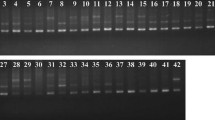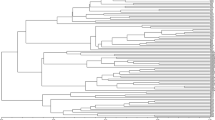Abstract
Mulberry (Morus L.) is essential for the sericulture industry as the primary feed for the silkworm Bombyx mori L. in India, with its long tradition of practicing sericulture, has a large number of indigenous cultivars. Since knowledge on the genetic divergence of these cultivars/varieties is essential for proper conservation and utilization, Inter Simple Sequence Repeat (ISSR) profiling was employed to assess genetic relationships among 34 mulberry accessions, collected from different regions of India. By using 12 ISSR primers, which produced 72 markers displaying a high degree of polymorphism (94.4%), genetic dissimilarity coefficients were calculated for each pair of the accessions and clustering of the accessions with Unweighted Pair Group Method using Arithmetic average (UPGMA) analysis was done to unravel the genetic diversity among the accessions. The dissimilarity coefficients varied from 0.111 to 0.692. UPGMA analysis generated a dendrogram with six groups and five isolates. Clustering of the accessions did not correspond with the information on the geographic origin of many of the accessions. Two-dimensional representations of the relative positions of the accessions with regards to divergence using the first two canonical variates as co-ordinate axes revealed considerable variability among the cases in each group. Further, Discriminant Function Analysis (DFA) showed changes in the geographic origin of 11 accessions and species status of 20 accessions.
Similar content being viewed by others
References
Bornet B., Goraguer F., Joly G. and Branchard G. 2002. Genetic diversity in European and Argentinean cultivated potatoes (Solanum tuberosum subsp. tuberosum) detected by inter-simple sequence repeats (ISSRs). Genome 45: 481–484.
Breto M.P., Ruiz C., Pina J.A. and Asins M.J. 2001. The diversification of Citrus clementina Hort. ex Tan., a vegetatively propagated crop species. Mol. Phylogenet. Evol. 21: 285–293.
Charsley S. 1995. Anderson vs. the East India Company. Indian Silk 34: 11–14.
Dandin S.B., Kumar R., Rabin ran S. and Jolly M.S. 1987. Crossability studies in mulberry. Indian J. Sericulture 26: 11–14.
Das B.C. and Krishnaswami S. 1965. Some observations on interspecific hybridization in mulberry. Indian J. Sericulture 4: 1–8.
Deshpande A.U., Apte G.S., Bahulikar R.A., Lagu M.D., Kulkarni B.G., Suresh H.S., Singh N.P., Rao M.K., Gupta V.S., Pant A. and Renjekar P.K. 2001. Genetic diversity across natural populations of montane plant species from the Western Ghats, India revealed by inter simple sequence repeats. Mol. Ecol. 10: 2397–2408.
Dwivedi N.K., Sikdar A.K. and Jolly M.S. 1987. Colchicine induced variant in mulberry Morus alba var. Kanva-2. Indian J. Sericulture 26: 93–97.
Dwivedi N.K., Suryanarayanan N., Susheelamma B.N., Sikdar A.K. and Jolly M.S. 1988. Studies in colchicine induced mutants of mulberry. Sericologia 28: 531–540.
Dwivedi N.K., Suryanarayanan N., Susheelamma B.N., Sikdar A.K. and Jolly M.S. 1988b. Studies on Auto Triploids of Three High Yielding Variety of Tropical Mulberry Morus indica L. International Congress on Tropical Sericulture Practice, Bangalore, pp. 18–23.
Dwivedi N.K. 1990. Crossability studies in induced tetraploid of mulberry. Adv. Plant Sci. 3: 269–272.
Felsenstein J. 1993. PHYLIP (Phylogeny inference package) version 3.5c. Department of Genetics, University of Washington, Seattle.
Fotedar R.K. and Dandin S.B. 1998. Genetic divergence in the mulberry. Sericologia 38: 115–125.
Gangwar S.K. and Thangavelu K. 1992. Evaluation of bio-fertilizer for establishment of mulberry (Morus alba L.). Sericologia 32: 173–181.
Gururajan M.K. 1960. Varieties of mulberry — a classification. Indian Silk J. 1: 12–15.
Hooker J.D. 1885. Flora of British India 5: 91–493.
Introna F. Jr., Di V.G., Campobasso C.P. and Dragone M. 1997. Sex determination by discriminant analysis of calcanei measurements. J. Forensic Sci. 42: 725–728.
Iscan M.Y. and Miller-Shaivitz P. 1984. Discriminant functions in sexing of the libia. J. Forensic Sci. 29: 1087–1093.
Iyer Y.N. 1954. Field Crops of India with Reference to Mysore. The Bangalore Printing and Publishing Co. Ltd., Bangalore.
Jones C.J., Edward K.J., Castagglione S., Winfield M.O., Sale F., Vand de Wiel C., Bredemeijer G., Buiatti M., Maestri E., Malcevshi A., Marmiroli N., Alert R., Volkaert G., Rueda J., Linacero R., Vazquez A. and Karp A. 1997. Reproducibility of RAPD, AFLP and SSR markers in plants by network of European laboratories. Mol. Breed 3: 381–390.
Kadambi K. 1949. Morus alba Linn. The common mulberry. Indian Forester 75: 459–466.
Karp A., Kreosovich S., Bhat K.V., Ayada W.G. and Hodgkin T. 1997. Molecular tools in plant genetic resources conservation: a guide to the technologies. IPGRI Tech Bull. No. 2.
Koidzumi G. 1917. Taxonomy and phytogeography of the genus Morus. Bull. Seric. Exp. Station, Tokyo (Japan) 3: 1–62.
Kirsur M.V. 2002. The distressed dreams: Anderson the man and his mission part II. Indian Silk 4(9): 24–26.
Linneaus C. 1753. Species Plantarum, Stockholm, pp. 986.
Mahalanobis P.C. 1936. On the genetical distance in statistics. Proc. Nat. Inst. Sci. India 2: 265–275.
Mala V.R., Chaturvedi H.K. and Sarkar A. 1997. Multivaraite analysis as an aid to accession selection for breeding in mulberry. Indian J. Sericulture 36: 111–115.
Minamizawa K. 1963. Experimental studies on the sex determination in mulberry. Bull. Fac. Tokyo Noko Digaku 7: 4–47.
Mukherjee S.K. 1965. On some morphological evidence in floral structure towards the development of unisexuality in mulberry. Indian J. Seric. 4: 1–7.
Nei M. and Li W. 1979. Mathematical model for study the genetic variation in terms of restriction endonucleases. Proc. Natl Acad. Sci. USA 74: 5267–5273.
Press S.J. and Wilson S. 1978. Choosing between logistic regression and discriminant analysis. J. Am. Stat. Assoc. 73: 699–705.
Rahman M.S., Doss S.G., Vijayan K., Setua M. and Roy B.N. 1999. Performance of improved varieties of mulberry under rainfed cultivation in West Bengal. Indian J. Agric. Sci. 69: 752–754.
Raina S.N., Rani V., Kojima T., Ogihara Y., Singh K.P. and Devarumath R.M. 2001. RAPD and ISSR finger prints as useful genetic markers for analysis of genetic diversity. Varietal identification, and phylogenetic relationships in parent (Arachis hypogea) accessions and wild species. Genome 44: 763–772.
Ravindran S., Rao V.A., Naik V.G., Tikader A., Mukheerjee P. and Thangavelu K. 1997. Distribution and variations in mulberry germplasm. Indian J. Plant Genet. Resour. 10: 233–242.
Sahu P.K., Yadav B.R.D. and Saratchandra B. 1995. Evaluation of yield component in mulberry germplasm varieties. Acta Botanica Indica 23: 191–195.
Sau H., Sahu P.K., Yadav B.R.D. and Saratchandra B. 1995. Evaluation of mulberry (Morus spp.) genetic resources. I. Sprouting, survival and rooting ability. J. Envtl. Resour. 3: 11–13.
Sastry C.R. 1984. Mulberry varieties, exploitation and pathology. Sericologia 24: 333–359.
Sneath P.H.A. and Sokal R.R. 1973. Numerical Taxonomy. W.H. Freeman, San Francisco.
Thangavelu K., Mukherjee P., Tikader A., Ravindran S., Goel A.K., Rao A.A., Naik V.G. and Sekar S. 1997. Catalogue on Mulberry (Morus spp.) Germplasm. Central Sericultural Germplasm Resource Centre, Hosur, Tamil Nadu, India.
Tikader A. and Roy B.N. 2001. Multivariate analysis in some mulberry (Morus spp.) germplasm accessions. Indian J. Sericulture 40: 168–170.
Vijayan K., Das K.K., Doss S.G., Chakraborti S.P. and Roy B.N. 1999. Genetic divergence in indigenous mulberry (Morus spp.) accessions. Indian J. Agric. Sci. 69: 851–853.
Wu Y.Y., Zhang T.Z. and Yin J.M. 2001. Genetic diversity detected by DNA markers and phenotypes in upland cotton. YI Chuan Xue Bao 28: 1040–1050.
Yadav B.R.D. and Kumar T.G.N. 1993. Response of mulberry (Morus indica var. Kanva-2) to inoculation with nitrogen fixing bacterium Azospirillium crasilense. Sericologia 33: 635–640.
Tikader A., Vijayan K., Raghunath M.K., Chakraborti S.P., Roy B.N. and Pavankumar T. 1995. Studies on sexual variabilities in Mulberry (Morus Spp.). Euphytica 84: 115–120.
Author information
Authors and Affiliations
Corresponding author
Rights and permissions
About this article
Cite this article
Vijayan, K., Nair, C.V. & Chatterjee, S.N. Molecular characterization of mulberry genetic resources indigenous to India. Genet Resour Crop Evol 52, 77–86 (2005). https://doi.org/10.1007/s10722-005-0288-y
Received:
Accepted:
Issue Date:
DOI: https://doi.org/10.1007/s10722-005-0288-y




